What Temperature Should Ground Beef Be Delivered
Footing Beefiness: the Almost Pop Meat Ground beef patties are the most popular beef item for United states consumers; about 12 billion hamburgers were consumed by Americans in 2007 (three). Ground beef patties are the most oftentimes grilled meat (1). Ground beefiness is also popular in other forms such as meat loaf, meat balls, sloppy joes, and tacos.  How To Handle and Cook Ground Beef Equally explained below (run into Why is Raw Ground Beef Singled Out by Food Safety Experts?), the unique character of ground beef warrants careful handling. Avoid Contaminating Other Foods with Raw Meat or Raw Meat Juice
How To Handle and Cook Ground Beef Equally explained below (run into Why is Raw Ground Beef Singled Out by Food Safety Experts?), the unique character of ground beef warrants careful handling. Avoid Contaminating Other Foods with Raw Meat or Raw Meat Juice
Use a Thermometer to Insure Ground Beefiness Reaches the Safely Cooked Internal Temperature of 160°F  Destruction of the pathogens that may be nowadays in raw ground beef, particularly E. coli, requires a cooking procedure that heats the beef to an internal temperature of 160°F (20). Use of a food thermometer is the but fashion to decide that the internal temperature of basis beef patties has reached 160°F (thirteen, 19). (Unfortunately, only xiii% of consumers e'er or often utilize a thermometer when cooking or grilling hamburgers (nine).) Larn how to apply a food thermometers when cooking ground beefiness: The Academy of Idaho Extension website, "All Well-nigh Food Thermometers" provides information about cooking with nutrient thermometers, including information about how to choose a nutrient thermometer and how to use one.
Destruction of the pathogens that may be nowadays in raw ground beef, particularly E. coli, requires a cooking procedure that heats the beef to an internal temperature of 160°F (20). Use of a food thermometer is the but fashion to decide that the internal temperature of basis beef patties has reached 160°F (thirteen, 19). (Unfortunately, only xiii% of consumers e'er or often utilize a thermometer when cooking or grilling hamburgers (nine).) Larn how to apply a food thermometers when cooking ground beefiness: The Academy of Idaho Extension website, "All Well-nigh Food Thermometers" provides information about cooking with nutrient thermometers, including information about how to choose a nutrient thermometer and how to use one.  The USDA'due south Food Safe and Inspection Service Thermometers and Food Safe page likewise provides information nearly thermometers and how to apply them.
The USDA'due south Food Safe and Inspection Service Thermometers and Food Safe page likewise provides information nearly thermometers and how to apply them.  Basis beefiness patties should exist tested for the safely cooked temperature of 160°F in several locations because the entire patty does not accomplish i temperature at the aforementioned fourth dimension. Additionally, the lowest temperature is not always in the eye of the patty (xvi). Why is Raw Ground Beefiness Singled Out past Food Condom Experts?
Basis beefiness patties should exist tested for the safely cooked temperature of 160°F in several locations because the entire patty does not accomplish i temperature at the aforementioned fourth dimension. Additionally, the lowest temperature is not always in the eye of the patty (xvi). Why is Raw Ground Beefiness Singled Out past Food Condom Experts?  Although other meats have caused foodborne illness, there are several attributes of ground beef which suggest that more than careful handling–specially use of a thermometer to cook to 160°F– is required. Footing Beefiness May Contain Pathogens Throughout Retail ground beefiness may contain pathogens (disease-causing microorganisms), most notably Escherichia coli O157:H7 and Salmonella enterica. These pathogens are often associated with nutrient animals, and E. coli O157:H7 is particularly associated with ruminant animals.
Although other meats have caused foodborne illness, there are several attributes of ground beef which suggest that more than careful handling–specially use of a thermometer to cook to 160°F– is required. Footing Beefiness May Contain Pathogens Throughout Retail ground beefiness may contain pathogens (disease-causing microorganisms), most notably Escherichia coli O157:H7 and Salmonella enterica. These pathogens are often associated with nutrient animals, and E. coli O157:H7 is particularly associated with ruminant animals.
 Illnesses Accept Been Associated with Ground Beef Consumers have developed E. coli O157:H7 infections from consumption of undercooked ground beef.
Illnesses Accept Been Associated with Ground Beef Consumers have developed E. coli O157:H7 infections from consumption of undercooked ground beef.
Previous Communication to Consumers to Employ Cooked Meat Color as an Indicator of Condom Footing Beef was Wrong Prior to 1997, consumers were encouraged to melt ground beef until "brown" in the centre to assure a safety temperature had been reached (11). However, enquiry conducted in the 1990s determined that cooked ground beef color does not correlate to rubber endpoint temperature (2, 6, 7, xi). Ground beef tin turn brown before it reaches 160°F or it may retain a pink color at temperatures higher up 160°F–cooked color change in footing beefiness depends on a number of factors, including pH, meat source, packaging, freezing history and added ingredients (8).
These photos illustrate the color-temperature disconnect for ground beefiness patties: 

The simply way to determine that footing beef patties, or other products formed from ground beef, such as meat loaf or large meat balls, are safely cooked is to utilize a thermometer to determine the safe temperature of 160°F has been reached. (Normal cooking practice for small-scale ground beef products such equally crumbles means they are generally cooked to well above 160°F.)
Labels on Packages of Frozen Ground Beef Patties Do Not Always Provide Cooking Instructions That Outcome in Safely Cooked Patties

A contempo survey of labels on packages of frozen ground beef patties (4 oz. size) revealed some packages suggest cooking times of ane.5 to 2 min/side. Enquiry on consumer cooking procedures indicates that cooking times of less than three min/side could not produce a safely cooked product, thus some packages provided unsafe instructions. Frozen ground beef patties generally required vii to 9 min full cooking time and starting with a room temperature pan (not preheated) extends the cooking time past about 4 min. Furthermore, melt times on a propane grill are more variable in than a fry pan on the electric stove. Bottom line: The variability of cooking times for patties makes it Packaging also gave conflicting information most the use of cooked color to predict doneness and nearly fugitive both overcooking and undercooking, provided an array of confusing instructions for consumers (12).

Since 1994, federal regulations require a Safe Handling Label, which includes information about storing, cooking, and avoiding cross contamination, on all consumer packages of footing beef (and other raw meat) (14).
Decision
Until ground beef is assured to be a pathogen-free product, consumers can all-time protect themselves and their loved ones past using a food thermometer to make sure cooked footing beefiness reaches a prophylactic temperature of 160°F.
References
1. American Meat Institute. 2007. Grills to Sizzle Over Holiday Weekend, May 26. http://www.meatami.com/ht/d/ReleaseDetails/i/3023.
two. Berry, B. W. and Thou.E. Bigner-George. 2000. Factors affecting color properties of beef patties cooked on an outdoor gas grill. J. Muscle Foods 11:213-226.
3. Cattleman's Beef Board. 2008. "I'll take a burger with a side of burger," CBB Checkoff News, http://www.beefboard.org. Accessed July eleven, 2008.
4. Davis, M. plus 34 others. 1993. Update: Multistate outbreak of Escherichia coli O157:H7 infections from hamburgers — Western United States, 1992-1993, Morb. Mort. Weekly Rep. 42(14):258-263.
5. DeWaal, C. S. and F. Bhuiya. 2007. Outbreak Alert! Center for Science in the Public Involvement, page 12, http://www.cspinet.org/foodsafety/outbreak_alert.pdf.
6. Hague, M.A.; Thousand.East. Warren; Grand.C. Chase; D.H. Kropf; C.Fifty. Kastner; S.Fifty. Stroda; and D.E. Johnson. 1994. Endpoint temperature, internal cooked color, and expressible juice color relationships in basis beef patties. J. Food Sci. 59(three): 465-470.
7. Killinger, Grand.1000., Yard.C. Chase, R.E. Campbell and D.H. Kropf. 2000. Factors affecting premature browning during cooking of store-purchased ground beef. J. Food Sci. 65(4):585-587.
8. Rex, North.J. and Whyte, R. 2006. "Does Information technology Look Cooked? A Review of Factors that Influence Cooked Meat Colour," J. Food Sci. 71(four):R31-R40.
ix. Lando, A. and L. Verrill. 2008. 2006 FDA/FSIS Food Safety Survey, http://www.fda.gov/Nutrient/ScienceResearch/ResearchAreas/ConsumerResearch/ucm080374.htm.
10. Lange, L. 2008. Beefiness trim baseline results and how FSIS will use, Presentation at Due east. coli Public Meeting, Apr 9, Washington, D.C., http://www.fsis.usda.gov/PPT/Beef_Trim_Baseline_040908.ppt. Accessed October 8, 2008.
eleven. Lyon, B. G., B. W. Berry, D. Soderberg, and Due north. Assure. 2000. Visual color and doneness indicators and the incidence of premature brown color in beef patties cooked to 4 finish indicate temperatures. J. Food Prot. 63(ten):1389-1398.
12. McCurdy, S.M., K.T. Takeuchi, Z. Edwards, Yard. Edlefsen, D-H. Kang, 5.Eastward. Mayes, and V. Due north. Hillers. 2006. Food safety education initiative to increase consumer apply of food thermometers in the United States. Br. Food J. 108:775-794.
13. McCurdy, S.Yard., Finley, K., and Zemmer, T. 2009. Label instructions and cooking times for retail frozen ground beef patties. Food Prot. Trends 29(six):335-341.
xiv. Ralston, K. L. and Lin, C. T. J. 2001. U.S. Condom Handling Labels for Meat and Poultry: A Case Study in Information Policy. Consumer Interests Annual, Book 47.
15. Rangel, J.Thou., P.H. Sparling, C. Crowe, P.Thou. Griffin, and D.L. Swerdlow. 2005. Epidemiology of Escherichia coli O157:H7 outbreaks, U.s., 1982-2002. Emerging Infect. Dis. eleven(4):603-609.
16. Rhee, Thousand.S., S.Y. Lee, Five.N. Hillers, Due south.Grand. McCurdy, and D-H. Kang. 2003. Evaluation of consumer -fashion cooking methods for reduction of Escherichia coli O157:H7 in footing beef. J Food Prot. 66:1030-1034.
17. Shillamplus, P. plus 12 others. 2002. Multistate outbreak of Escherichia coli O157:H7 infections associated with eating ground beefiness — United States, June–July 2002, Morb. Mortal. Weekly Rep. 51(29):637-639.
eighteen. Slutsker, L., A.A. Ries, K. Maloney, J.Yard. Wells, K.D. Greene, and P.Thou. Griffin. 1998. A nationwide case-command report of Escherichia coli O157:H7 infection in the United states of america, J. Infect. Dis. 177:962-966.
nineteen. U.Southward. Section of Agronomics, Nutrient Condom and Inspection Service. 2008a. Food Safety Pedagogy: Thermy™, http://www.fsis.usda.gov/food_safety_education/thermy/index.asp, accessed June xxx, 2008. http://www.fsis.usda.gov/News_&_Events/R01-2008_release/index.asp, accessed June 30, 2008.
20. U.S. Section of Agriculture, Nutrient Safety and Inspection Service. 2003a. Color of cooked ground beef every bit it relates to doneness, http://www.fsis.usda.gov/FactSheets/Color_of_Cooked_Ground_Beef/alphabetize.asp.
21. U.South. Department of Agriculture, Food Condom and Inspection Service. 2002. Backgrounder: New measures to address Eastward. coli O157:H7 contamination. http://www.fsis.usda.gov/OA/groundwork/ec0902.pdf, accessed June 30, 2008.
Source: https://www.foodsafetynews.com/2009/08/ground-beef-the-importance-of-safe-handling-practices-and-accurate-final-product-temperature/
0 Response to "What Temperature Should Ground Beef Be Delivered"
Postar um comentário